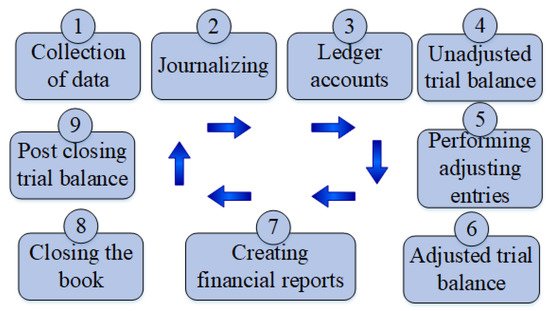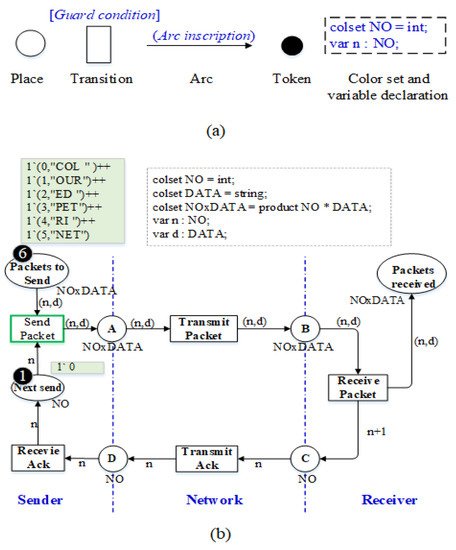
| Version | Summary | Created by | Modification | Content Size | Created at | Operation |
|---|---|---|---|---|---|---|
| 1 | Chanon Dechsupa | + 1232 word(s) | 1232 | 2021-12-16 07:50:53 | | | |
| 2 | Jessie Wu | Meta information modification | 1232 | 2022-01-10 03:09:07 | | | | |
| 3 | Lindsay Dong | Meta information modification | 1232 | 2022-03-28 08:09:08 | | |
Video Upload Options
Many learners who are not familiar with the accounting terms find blended learning very complex to understand with respect to the computerized accounting system, the journal entries process, and tracing the accounting transaction flows of accounting system. A simulation-based model is a viable option to help instructors and learners make understanding the accounting system components and monitoring the accounting transactions easier. This entry briefly introduce a colored Petri net (CPN)-based model.
1. Background
Petri-net-based techniques have been used in computer science to validate a concurrent system. There is no research that directly provides a Petri-net-based technique for an instruction of the accounting system. This entry describes the accounting software, and the researches that proposes the Petri-net-based techniques in computer science and business process domain.
2. Computer-Aided Instruction and Accounting Information Systems

-
Point of sale module (POS module): this represents the place where the raw financial transactions takes place. The financial transactions may be posted by hand or automated by an integrated POS module. In the integrated POS module, the account mapping profile is used to map the raw financial transactions into the accounting transactions.
-
Chart of account module or COA: A chart of accounts is manipulated at the COA module, on which the accounts in the list are classified into five series: assets, liabilities, equity, revenue, and expenses.
-
Accounts receivable module: accounts receivable handles the invoicing and manages the customer payments.
-
Accounts payable module: accounts payable handles the recording and tracking of the money owned by a business.
-
General ledger module: the general ledger module is responsible for consolidating the accounting information from the point of sale module, accounts receivable module, and accounts payable module. Financial reports are computed from the accounting transactions stored in the general ledger module, and these transactions may be used for auditing purposes.
-
Trial balance module: the trial balance module shows a listing of accounts that come along with the net balance of each account. It is useful for an internal checking because a trial balance can disclose the net balance both before adjustment and after adjustment, and it comprises the primary data for creating the balance sheet, income statement and cash flow report.
-
Balance sheet module: this details a list of the organization assets, liabilities, and equity. It also be used to create and estimate the clash flow budget.
3. Colored Petri Net

References
- Collins, D.; Deck, A.; McCrickard, M. Computer aided instruction A study of student evaluations and academic performance. J. Coll. Teach. Learn. 2008, 5, 49–58.
- Cooper, J.P.; Pattanayak, S. Chart of Accounts: A Critical Element of the Public Financial Management Framework; Citeseer: Princeton, NJ, USA, 2011.
- Bryer, R.A. Double-entry bookkeeping and the birth of capitalism: Accounting for the commercial revolution in medieval northern Italy. Crit. Perspect. Account. 1993, 4, 113–140.
- Jensen, K.; Kristensen, L.M.; Wells, L. Coloured Petri Nets and CPN Tools for modelling and validation of concurrent systems. Int. J. Softw. Tools Technol. Transf. 2007, 9, 213–254.
- Baier, C.; Katoen, J.P. Principles of Model Checking; MIT Press: Cambridge, MA, USA, 2008.
- Fisher, M. An Introduction to Practical Formal Methods Using Temporal Logic; John Wiley & Sons: Hoboken, NJ, USA, 2011; Volume 82.
- Clarke, E.M.; Klieber, W.; Nováček, M.; Zuliani, P. Model checking and the state explosion problem. In LASER Summer School on Software Engineering; Springer: Berlin/Heidelberg, Germany, 2011; pp. 1–30.
- Koch, I. Petri nets in systems biology. Softw. Syst. Model. 2015, 14, 703–710.
- Blätke, M.A.; Heiner, M.; Marwan, W. Petri Nets in Systems Biology; Technical Report; Otto von Guericke University Magdeburg: Magdeburg, Germany, 2011.
- Pinney, J.W.; Westhead, D.R.; McConkey, G.A. Petri Net representations in systems biology. Biochem. Soc. Trans. 2003, 31, 1513–1515.
- Heiner Monika, D.G.; Donaldson, R. Petri nets for systems and synthetic biology. In Proceedings of the International School on Formal Methods for the Design of Computer, Communication and Software Systems, Bertinoro, Italy, 2–7 June 2008; pp. 215–264.
- Liu, F. Colored Petri Nets for Systems Biology. Master’s Thesis, Brandenburg University of Technology, Cottbus, Germany, 2012.




